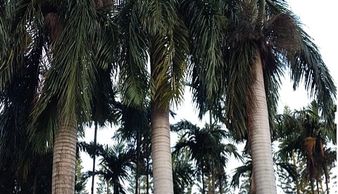Translate:
Florida Irritant and Allergy Guide
Ragweed
Dust Mite
Dust Mite

What is it: one of the most common causes of allergic rhinitis, this flowering plant produces a large amount of pollen granules each pollen season which typically occurs in August- September. In Florida, ragweed can potentially flower year round
How to identify it: The ragweed plant is made of multiple leaflets in fern pattern. The flowers are jagged. It is often confused with Goldenrod which has bright yellow slender leaves. This distinction is important because Goldenrod does not put pollen in the air and is instead pollinated by insects
Where is it found: mainly distributed in tropical regions, commonly found in southern part of the United States and Mexico. However, ragweed can be found in almost every state in the USA
Dust Mite
Dust Mite
Dust Mite

What is it: Dust mites are microscopic pests found in the majority of homes no matter how clean. Dust mites do not sting or bite, they are significant due to the allergy symptoms they cause. They feed off dead human and pet skin cells. The dust mite feces are what causes allergy symptoms.
How to identify it: dust mites are too small to see with the human eye but can be see under a microscope.
Where is it found: dust mites prefer high humidity areas and temperatures of approximately 68 to 80 degrees Fahrenheit. While steps can be taken to reduce dust mites, testing has found dust mites in 84 % of households in the United States.
Oak Tree
Oak Tree
Oak Tree

What is it: Native to North America, the oak tree can live past 300 years old. The fruit of an oak is a nut called an acorn. Oak trees are a common cause of allergic rhinitis as the trees have an extended period of pollen production. Oak tree pollen season is typically February to May.
How to identify it: Oak trees have spirally arranged leaves. If you see a tree with acorns, it is an oak tree.
Where is it found: residential areas, parks. Oak trees are found in both cool and tropical environments. Oak trees are found throughout South Florida.
Oak Tree
Oak Tree
.
Florida Allergy and Irritant Guide
Melaleuca Tree
Melaleuca Tree
Melaleuca Tree

What is it: originally from Australia, it was brought to the United States, in the early 1900s. Farmers were looking for a way to drain the marshes to produce new areas to farm. Melaleuca trees, consume large amounts of water which can be used to dry up the swampland. Melaleuca is highly invasive and can take over wide areas of land rapidly.
How to identify: tree is 50 to 80 feet tall, flowers form a spike.
Where is it found: Melaleuca covers a half-million acres of area, More prominent close to the Everglades
Bahia Grass
Melaleuca Tree
Melaleuca Tree

What is it: A tropical, perennial grass. typically pollen season is late spring, early summer however Bahia grass can produce pollen granules year round.
How to identify: low growing, with flat hairless leaves, leaves taper to a fine point
Where is it found: Tropical areas, southern United States, native to Mexico and South America, Commonly used in lawns in South Florida
Bermuda Grass
Melaleuca Tree
Queen Palm Tree

What is it: The genus Cynodon, originated in Africa, fast growing grass, durable making it effective for sports fields and golf courses to recover from damage quickly
How to identify: dark green color, typically does not grow beyond 2 inches,
Where is it found: tropical climate. Commonly found in lawns, golf courses, athletic fields
Queen Palm Tree
Queen Palm Tree
Queen Palm Tree

What is it: Part of the Arecaceae family, there are 2600 species of palm tree with most of them being found exclusively in tropical climates. The Queen Palm tree is a medium size usually growing up to 15 meters tall.
How to identify: straight, branchless, large evergreen leaves, leave structure known as fronds
Where is it found: native to tropical and subtropical climates. Native to Brazil, Argentina, Paraguay
Red Tide
Queen Palm Tree
Red Tide

What is it: A red tide is a higher-than-normal concentration of a microscopic algae. Red tide is caused by farming fertilizer runoff and other pollutants. Along Florida’s west coast the species that causes red tides is Karenia brevis. It has the ability to kill dolphins, sea turtles marine life. Warmer waters can drive up the presence of red tide. The red tide emits a toxin which can effect respiration.
Effects: The most common symptoms of red tide exposure is a tickle in your throat. Also exposure can cause rash, red itchy eyes, coughing and wheezing.
What to do if you are exposed: Avoidance of red tide is the best course of action. However if exposure does occur seek medical attention immediately. Antihistamines as well as corticosteroids can be used in certain situations. Other measures can be taken if an individual is having difficulty breathing
Guide
Queen Palm Tree
Red Tide

This page is not intended to replace medical advice from your physician. If you are experiencing allergy symptoms consult your physician immediately.
Copyright © 2018 Sean Hess Allergy - All Rights Reserved.
Powered by GoDaddy